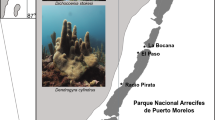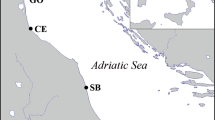Abstract
Cultures of the freshwater ostracod Herpetocyprisbrevicaudata were kept under laboratory conditions in ordertostudy effects of water temperature on development time andcalcification process. Four culture temperatures were used:12.4,14.6, 19.8 and 23.3 °C.H. brevicaudata cultured at 19.8 and 23.3 °Cshowedhigher survival rate and faster development than thosecultured at12.4 and 14.6 °C. Water temperature also has a clearinfluence on the degree of calcification of the ostracodshells.For H. brevicaudata, the 15–19 °C temperaturerangeconstitutes a threshold below which Ca content of valvessignificantly decreases. Time required to calcify is alsolongerbelow this threshold. The increase of the calcification timedue tolower water temperatures seems to induce low survivalrates.
Similar content being viewed by others
References
Bate, R. H. & B. A. East, 1972. The structure of the ostracod carapace. Lethaia 5: 177–194.
Benson, R. H., 1981. Form, function, and architecture of ostracod shells. Ann. Rev. Earth Planet. Sci. 9: 59–80.
Beyer, G. & C. Meisch, 1996. Freshwater Ostracoda (Crustacea) collected on La Gomera (Canary Islands), with a redescription of Cypridopsis obesa(Brady & Robertson, 1869). Trav. sci. Mus. nat. hist. nat. Lux. 23: 29–56.
Chivas, A. R., P. De Deckker & J. M. G. Shelley, 1983. Magnesium, strontium and barium partitioning in non-marine ostracod shells and their use in paleoenvironmental reconstructions–a preliminary study. In Maddocks, R. F. (ed.), Applications of Ostracoda, Proceedings of the Eight International Symposium on Ostracoda, Univ. Houston Geosc.: 238–249.
Chivas, A. R., P. De Deckker & J. M. G. Shelley, 1986. Magnesium and strontium in non-marine ostracod shells as indicators of palaeosalinity and palaeotemperature. Hydrobiologia 143: 135–142.
Cohen, A. C. & J. G. Morin, 1990. Patterns of reproduction in ostracods: a review. J. crust. Biol. 10: 184–211.
Dalingwater, J. E. & H. Mutvei, 1990. Arthropod Exoskeletons. In Carter, J.G. (ed.), SkeletalBiomineralization: Patterns, Processes and Evolutionary Trends, vol. I: 83–96.
Forester, R. M., 1991. Ostracod assemblages from springs in the Western United States: implications for paleohydrology. Mem. ent. Soc. Can. 155: 181–201.
Geiger, W., 1990. Field and laboratory studies on the life-cycle of Cytherissa lacustris(Sars) (Crustacea, Ostracoda) with special emphasis on the role of temperature. Bull. Inst. géol. Bassin d’Aquitaine 47: 191–208.
Heip, C., 1976. The life-cycle of Cyprideis torosa(Crustacea, Ostracoda). Oecologia 24: 229–245.
Kesling, R. V., 1951. The morphology of ostracod molt stages. Illin. Biol. Monogr. 21, 324 pp.
Martens, K., 1985. Effects of temperature and salinity on postembryonic growth in Mytilocypris henricae(Chapman) (Crustacea, Ostracoda). J. crust. Biol. 5: 258–272.
Mezquita, F., A. Sanz-Brau & M. R. Miracle, 1996. New data on freshwater ostracod assemblages (Crustacea, Ostracoda) from Cuenca (Central Spain). Bull. Soc. Nat. luxemb. 97: 239–247.
Nüchterlein, H., 1969. Süßwasserostracoden aus Franken. Ein Beitrag zur Systematik und ökologie der Ostracoden. Int. Revue ges. Hydrobiol. 54: 223–287.
Roca, J. R. & A. Baltanas, 1993. Ecology and distribution of ostracoda in Pyrenean springs. J. crust. Biol. 13: 165–174.
Rosenfeld, A., 1979. Structure and secretion of the carapace in some living ostracods. Lethaia 12: 353–360.
Sohn, I. G. & L. S. Kornicker, 1988. Ultrastructure of Myodocopid shells (Ostracoda). In Hanai, T., N. Ikeya & K. Ishizaki (eds), Evolutionary Biology on Ostracoda, Proceedings of the Ninth International Symposium on Ostracoda: 243–258.
Turpen, J. B. & R. W. Angell, 1971. Aspects of molting and calcifi-cation in the ostracod Heterocypris. Biol. Bull. 140: 331–338.
Author information
Authors and Affiliations
Rights and permissions
About this article
Cite this article
Roca, J.R., Wansard, G. Temperature influence on development and calcification of Herpetocypris brevicaudata Kaufmann, 1900 (Crustacea: Ostracoda) under experimental conditions. Hydrobiologia 347, 91–95 (1997). https://doi.org/10.1023/A:1003067218024
Issue Date:
DOI: https://doi.org/10.1023/A:1003067218024




